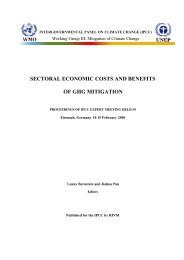Pacific Islands Environment Outlook - UNEP
Pacific Islands Environment Outlook - UNEP
Pacific Islands Environment Outlook - UNEP
Create successful ePaper yourself
Turn your PDF publications into a flip-book with our unique Google optimized e-Paper software.
20<br />
STATE OF THE ENVIRONMENT<br />
425<br />
400<br />
375<br />
350<br />
Figure 1.7: Projected sea-level rise with adherence<br />
to Kyoto Protocol<br />
Atmospheric CO2 (ppm)<br />
450<br />
observed<br />
325<br />
300<br />
275<br />
predicted<br />
250<br />
1880 1990 2100<br />
Temperature (°C)<br />
1.2<br />
observed<br />
1.0<br />
0.8<br />
0.6<br />
0.4<br />
0.2<br />
0<br />
-0.2<br />
-0.4<br />
-0.6<br />
-0.8<br />
1880<br />
Sea level change (cm)<br />
40<br />
observed<br />
30<br />
20<br />
10<br />
0<br />
-10<br />
-20<br />
-30<br />
1880<br />
predicted<br />
High Medium Low<br />
1990 2100<br />
predicted<br />
High Medium Low<br />
1990 2100<br />
Observed global mean atmospheric CO 2 concentrations,and temperature and<br />
sea-level changes to 1990 compared with projections to 2100 based on the<br />
IS92a emissions scenario to 2000, with a gradual application of the Kyoto<br />
Protocol to 2020 followed by a return of all greenhouse gas emissions to<br />
natural values from 2025 (Scenario 2). Projections of temperature and sea<br />
level are based on low, mid and high temperature sensitivity (1.5°C, 2.5°C and<br />
4.5°C) and mid-value ice-melt parameters, as in IPCC (1996). Observed data<br />
are as in IPCC (1996).<br />
the early 1990s. Tuvalu was hit by an average of three<br />
cyclones per decade between the 1940s and 1970s, but<br />
eight occurred in the 1980s (Nunn 1990).<br />
Trends forecast to 2010<br />
Observations of the past ten years have been further<br />
examined in recent studies of latent energy in the ocean<br />
system and regional impacts (Jones 1998; Jones et al.<br />
1999). It has been predicted (Jones 1998) that sea-level<br />
rise resulting from anthropogenic greenhouse gases<br />
already in the atmosphere has the potential to threaten<br />
all regions of the <strong>Pacific</strong>, particularly in areas where<br />
coastal impacts are currently marginal. The CSIRO<br />
models determined that sea-level rise caused by past<br />
human emissions of greenhouse gases would be of the<br />
order of 5–12 cm, peaking in 2020–25 (Jones 1998). Sealevel<br />
rise likely if the provisions of the Kyoto Protocol<br />
were adhered to, and if the world then ceased all<br />
anthropogenic greenhouse gas emissions after 2020,<br />
would range between 14 cm and 32 cm, peaking in<br />
2050–2100 (Figure 1.7).<br />
The prediction of regional impacts associated with<br />
climate change over the next ten years (Jones et al.<br />
1999) further reinforces the concerns raised during the<br />
last decade. Coastal areas will continue to experience<br />
impacts associated with ENSO variability, tropical<br />
cyclones and wave action. Tropical cyclones may<br />
become more intense, which would increase storm<br />
surge height. Current risks are therefore likely to<br />
persist and probably increase at a rate determined by<br />
sea-level rise (Jones et al. 1999).<br />
Conclusions<br />
Climate change and sea-level rise are expected to have<br />
profound effects on the <strong>Pacific</strong> islands and the issue is<br />
therefore expected to remain a priority for the region.<br />
PICs have experienced a range of impacts<br />
consistent with a changing climate. A general alteration<br />
occurred in the South <strong>Pacific</strong> climate<br />
from the mid-1970s, and the intensity of extreme<br />
events, such as the 1998 El Niño induced droughts in<br />
Fiji, PNG and the FSM which resulted in severe<br />
damage to food and export crops, has caused<br />
considerable concern.<br />
Based on current models and on the assumption that<br />
the Kyoto Protocol targets are met, coastal areas will<br />
continue to suffer phenomena resulting from ENSO<br />
variability, tropical cyclones and wave action. Tropical<br />
cyclones may become more intense, which would<br />
increase storm surge height.

















